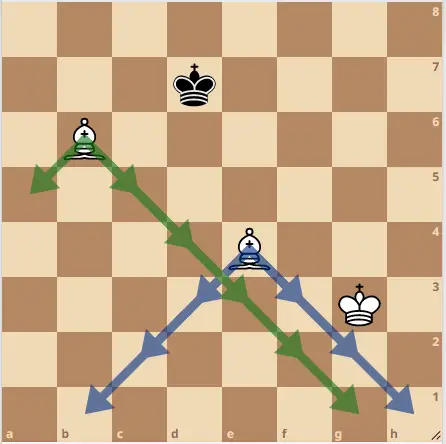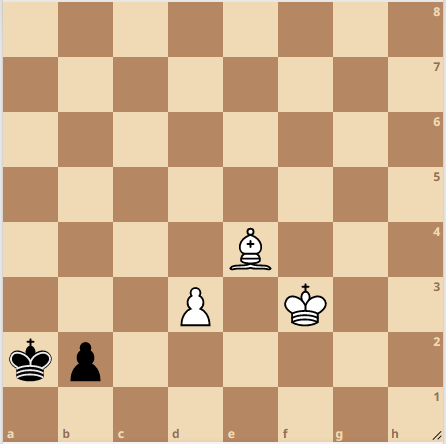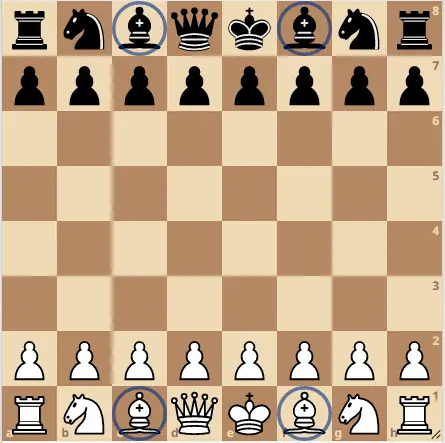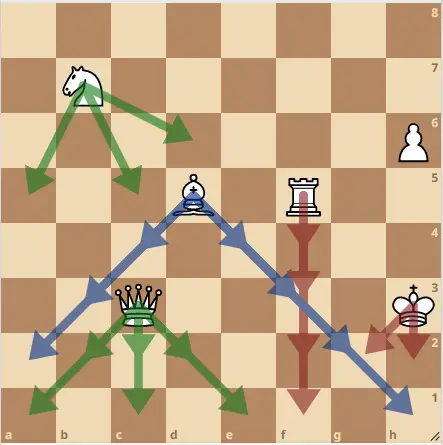Bishops are highly treasured by grandmasters. They are long ranged pieces which makes them extremely powerful and dangerous.
If you are beginner just starting to learn chess, you may be fascinated with how the bishop moves. One question I get a lot from beginner players is “Can the bishop move backwards in chess?” Well, here is what you should know:
Can The Bishop Move Backwards In Chess?
Yes, the bishop is a long ranged piece that can move diagonally backwards. It’s not limited to any number of squares. This means it can move diagonally as far as possible from one end of the chess board to the other. This makes it a very powerful piece, and in some cases can outperform even a rook.
The Bishop can move diagonally backwards as shown by the arrows

So what use does the bishop has moving backwards?
Well, one of the most important functions of a bishop is to control key squares in the position from a far. Unlike the knight, the bishop can quickly move from one end of the board to the other. This makes it the ideal piece for protecting passed pawns or to stop them from promoting.
For example, in this position, white bishop is controlling the queening square on b1. In the event that black pushes the pawn to promote to a queen, the white bishop would immediately capture the Queen diagonally backwards and seal the draw.
White Bishop captures the Queen diagonally backwards after pawn to b1

Without the ability of the bishop to move backwards, it would be impossible to stop passed pawns. The bishop would be worth just as little as a pawn.
When Can’t The Bishop Move Backwards
There are just 3 scenarios in which a bishop cannot move backwards:
- The path to which the bishop moves backwards is blocked by its own piece
- The bishop is pinned to the king where it serves defensive duties.
- The bishop is in it’s initial position or on the back rank.
Let’s have a glance into each case.
1. The path to which the bishop moves backwards is blocked by its own piece
If the bishop is blocked by its own pieces then it may not move backwards until the pieces are cleared. For example, in the position below (black to move), the white bishop cannot move backwards to recapture the promoted pawn. The path is blocked by the d3 pawn.

The bishop also cannot move backwards on the other diagonal because the white king is on the f3 square which is blocking the path. In these types of positions, your own pieces are doing you an injustice. Black should win the game comfortably after pawn to b1.
2. The bishop is pinned to the king where it serves defensive duties.
A bishop may not move backwards if it is pinned to the king by an enemy piece. For example, in the position below the white bishop cannot move from the a8-h1 diagonal as the black bishop would threaten to take the king. Moving the bishop off this diagonal would be illegal. That means the bishop cannot move diagonally backwards to squares such as b1, c2, or d3.

The position is practically lost for white no matter whose move it is. Black is going to promote his pawn and the white bishop cannot recapture because it is pinned to the white king. Positions where a bishop is pinning a bishop is quite rare. However, it should be noticed.
3. The bishop is in it’s initial position or on the back rank.
At the start of the chess game, your bishops are on the backrank (1st rank for white, 8th rank for black). The bishops cannot move off the edge of the board so it’s impossibe for the bishops to move backwards from their backrank.
The bishops would need to move diagonally forward from their initial position in order for them to move backwards.
Bishops in their starting position cannot move backwards

The same goes for all your pieces.
What Other Pieces Can Move Backwards?
The bishop is not the only piece that can move backwards. In fact, every other piece on the chessboard can move backwards with the excpetion of the pawns.
The pawns can only move one square forward or 2 squares on their first move. They can capture diagonally forward one square to the left or right.
Rooks can move up and down the chess board and sideways also. Knights move in a L-shaped direction, in other words, they move 2 squares like a rook and then one square at a right angle. The king can move in any direction one square at a time. Lastly is the queen. She can move in any direction, any number of squares in a straight line.
All the pieces can move backwards except the pawn

Should You Move Your Bishop Backwards?
If you want to get better at chess, there are certain principles and strategies you need to know. One strategy is that you should avoid moving your pieces backwards. A piece that is driven backwards is not participating fully in the game. You need to advance your pieces forward to active squares. That way you can take control of key squares in the position and set up attacking chances against the enemy king.
However, when it comes to the bishop, sometimes keeping it on the backrank is not such a terrible idea. Remember that bishops are long ranged pieces, so they could do a job from the backrank just as well as if they were in the center of the board.
This is why they always tell you to develop your knights before your bishop. If you pay attention, you will notice that the bishops are already developed after you pushed the e and d pawns which open up the diagonals. Moving your bishops would be a further developing move.
Nonetheless, a bishop that is actively placed in the center is always better than if it was placed on the backrank because it simply control more squares.
Final Verdict
The bishop is a powerful piece in chess. If given the chance, it can be even more deadly than a rook once the position opens up. This is even truer if you have a bishop pair.
Bishops can move backwards so long as the path is not blocked by one of your pieces and the move is legal. Moving your bishop backwards should not be labeled as a bad move. They can do the job well, even on the backranks.


